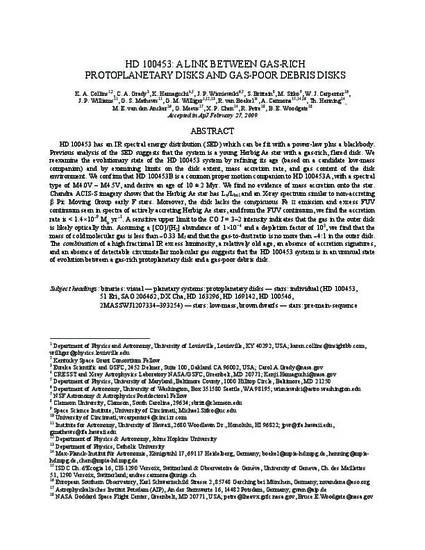
HD 100453 has an IR spectral energy distribution (SED) which can be fit with a power law plus a blackbody. Previous analysis of the SED suggests that the system is a young Herbig Ae star with a gas-rich, flared disk. We reexamine the evolutionary state of the HD 100453 system by refining its age (based on a candidate low-mass companion) and by examining limits on the disk extent, mass accretion rate, and gas content of the disk environment. We confirm that HD 100453B is a common proper motion companion to HD 100453A, with a spectral type of M4.0V-M4.5V, and derive an age of 10 ± 2 Myr. We find no evidence of mass accretion onto the star. Chandra ACIS-S imagery shows that the Herbig Ae star has L x/L bol and an X-ray spectrum similar to nonaccreting β Pic Moving Group early F stars. Moreover, the disk lacks the conspicuous Fe II emission and excess FUV continuum seen in spectra of actively accreting Herbig Ae stars, and from the FUV continuum, we find the accretion rate is < 1.4 × 10–9 M ☉ yr–1. A sensitive upper limit to the CO J = 3–2 intensity indicates that the gas in the outer disk is likely optically thin. Assuming a [CO]/[H2] abundance of 1 × 10–4 and a depletion factor of 103, we find that the mass of cold molecular gas is less than ~0.33 M J and that the gas-to-dust ratio is no more than ~4:1 in the outer disk. The combination of a high fractional IR excess luminosity, a relatively old age, an absence of accretion signatures, and an absence of detectable circumstellar molecular gas suggests that the HD 100453 system is in an unusual state of evolution between a gas-rich protoplanetary disk and a gas-poor debris disk.

This manuscript has been published in the Astrophysical Journal. Please find the published version here (note that a subscription may be necessary to access this version):
http://iopscience.iop.org/0004-637X/697/1/557
The American Astronomical Society holds the copyright in this article.